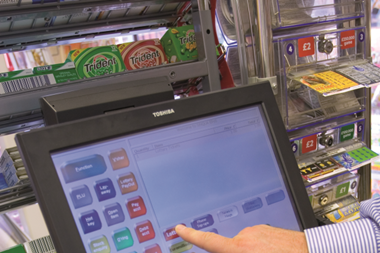Every building needs a strong foundation to survive, and the foundation of any decent convenience store is its epos system. Ramesh Shingadia of Londis Southwater, West Sussex, says that epos is crucial if a retailer wants his business to prosper.
“Epos is fundamental to a successful business,” he says. “It gives me much tighter control on my profit and stock by giving me a high level of transparency on three main aspects: how the shop overall is performing; how each department is performing; and profitability.”
Torex vice-president of petrol and convenience Jon Dunman believes that stock control is one of the main benefits of an epos system. “There are about 200 lines that make up 80% of a store’s turnover, but I would defy any retailer without epos to name them,” he says. “They may think they know, or have a guess, but thinking isn’t good enough for your customers, or your business. With an epos system you can list those 200 lines, but you can also find out when the key selling times are and if you’re stocking enough of them.
Technology
Technology is constantly evolving and epos is no exception. Partner Tech UK managing director Tim Van den Branden says that mobility is an issue his company is looking to address. “In 2011 we will be marketing our mobile epos solution,” he says. “Our EM-200 tablet computer has a variety of uses, from providing an extra till point during busy periods, to fulfilling back-office tasks.” Actinic’s Chris Barling believes that potential lies with contactless payments. “The key development in the next two years will be the rise of contactless payments,” he says. At Spedi Software, Koby Sunther is looking at a range of initiatives. “In 2011 we will be promoting electronic links between stores and their local suppliers; we are looking into how retailers can use their mobile phones for management reporting, and are investigating self-counting cash drawers.
“Even if you only discover what these ‘golden lines’ are and are able to focus on them, then the system has been a worthwhile investment.”
Partner Tech UK managing director Tim Van den Branden agrees that stock control is a big advantage of epos. “A retailer can see at the touch of a button that, say, sales of chocolate bars peak between Friday and Sunday and so make sure they have enough stock to meet demand at those times,” he says. “Suppliers, too, can benefit from understanding when and why items are sold, to inform and improve their marketing and advertising activities.”
Ramesh points out that epos can also help with stock control issues such as shrinkage. “Stock control is vital, because stock equals money,” he says. “Unless you have tight control, money is lost through theft and wastage. For example, I can look at my epos system and know that I should have 13 bottles of a certain brand of vodka. If I then look at what’s on the shelves and see that what is physically in my shop does not match the report, then I know that there is an issue I need to address.”
Spedi Software future business manager Koby Sunther estimates that the number of retailers using epos systems has grown in the past 12 months. “At the beginning of 2010, we estimated that about 25% of convenience stores were using epos,” he says. “This number is rising due to more suppliers providing software tailored to small unaffiliated stores we estimate by about 50%.”
However, according to HIM this figure is on the optimistic side and only 26% of retailers have an epos system in their store.
Despite the obvious benefits to retailers there still appears to be a reluctance to install it. PCMS group sales and marketing director Richard Goodall explains why: “Choosing an epos system can be a daunting task for a retailer,” he says. “They aren’t IT specialists and small groups of shops or independents don’t have the IT back-up team of the multiples. Therefore, understanding the complexities of different offerings can often be a barrier, despite the benefits on offer.”
Toshiba TEC retail sales director Peter Dodd adds that cost is still a factor for a lot of retailers. “A small convenience store owner may perceive that the cost of an epos system is too expensive, requiring a large capital investment,” he says.
Gardiff director Carl Harris says that any retailer looking to invest in epos needs to balance his needs against the cost. “Be clear about what you want your epos system to do,” says Harris. “Check for any ongoing costs and clarify whether any charges are made for enhancing or upgrading the system in the future.
Retailer’s view
“The Spedi system I use has stock and order functions which are straightforward for all levels of knowledge and experience, with the flexibility to control, intervene and influence the order process. Both functions have grids with information that can be laid out to my personal preference. “It’s important to have a system that handles those not-so-sexy, but still important areas of the business, such as waste and price adjustments. It’s also important to be able to control the more security-sensitive areas such as PayPoint and Lotto, as well as to organise staff hours and see which areas are most and least profitable. All this is made much easier with an efficient epos system.”
Julian Taylor-Green, Londis Lindford, Hampshire
“Also ask about payment methods. There may be an option to lease, rent or purchase. Many businesses lease epos systems these days as this is a good way of spreading the cost over the machine’s lifetime.”
Actinic CEO Chris Barling says that accessibility is vital for a retailer. “The system needs to be easy to use, and be a reasonable price while coming from an established supplier,” he says.
“A retailer should ask how many installations of this system there are in operation. You want the answer to be at least in the hundreds or else you are probably taking an unacceptable risk.”
Sunther says that if the system has been installed properly and the retailer has been shown how to use it, then it won’t take long for the benefits to show. “It usually takes up to six weeks for the retailer to enjoy the full benefits of the epos system, although some should become apparent almost immediately these include the ability to scan items at the till and print off shelf-edge labels. Typically, the system will have paid for itself within 12 to 18 months,” he says.
Harris adds that time saved on manpower will be evident quite quickly. “An epos system has the ability to carry out a number of tasks that would normally be carried out manually by a member of staff,” he says. “This frees up that staff member’s time, allowing them to be utilised elsewhere in store. This is the immediate effect but, of course, as the system beds in and the retailer uses more and more of its functionality, the benefits become even greater.”























No comments yet